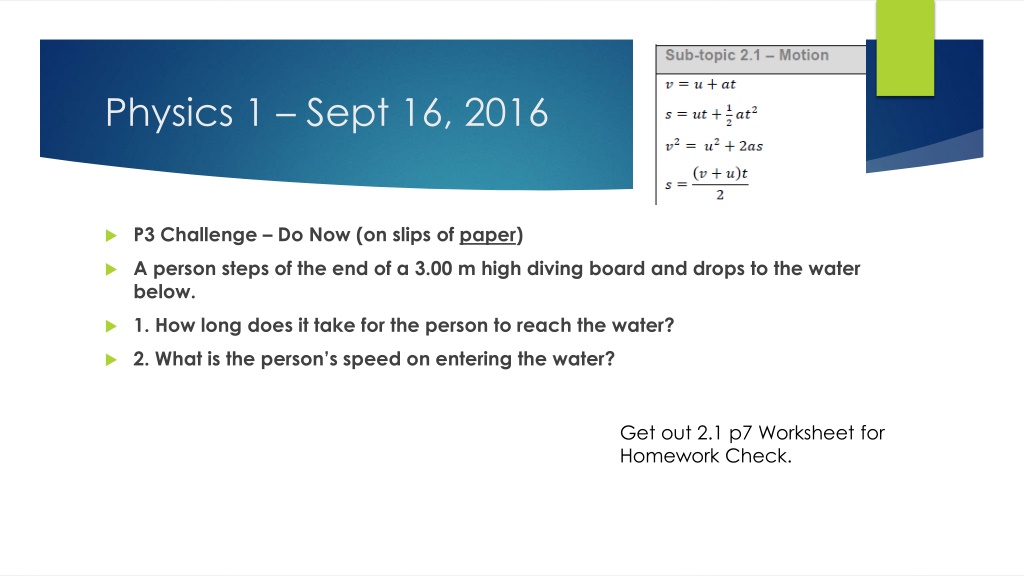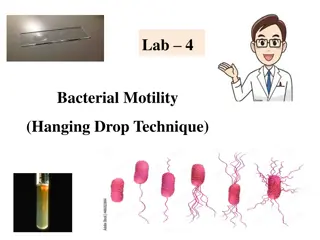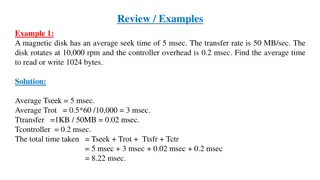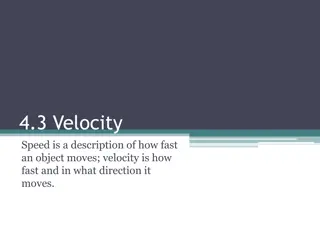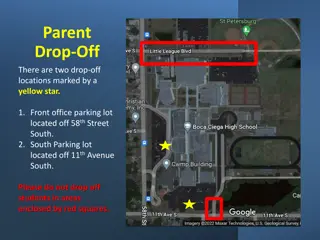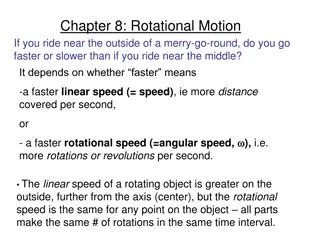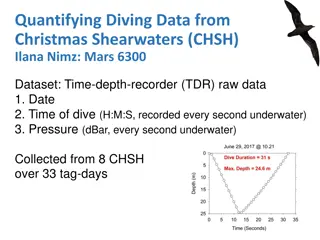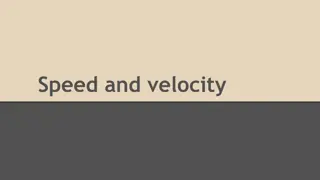Diving Board Drop: Time and Speed Calculations
Solve for the time taken and speed of a person dropping from a 3.00 m high diving board to the water below. Practice physics concepts related to motion, speed, and acceleration. Explore freefall scenarios to enhance understanding of 1D motion.
Download Presentation

Please find below an Image/Link to download the presentation.
The content on the website is provided AS IS for your information and personal use only. It may not be sold, licensed, or shared on other websites without obtaining consent from the author.If you encounter any issues during the download, it is possible that the publisher has removed the file from their server.
You are allowed to download the files provided on this website for personal or commercial use, subject to the condition that they are used lawfully. All files are the property of their respective owners.
The content on the website is provided AS IS for your information and personal use only. It may not be sold, licensed, or shared on other websites without obtaining consent from the author.
E N D
Presentation Transcript
Physics 1 Sept 16, 2016 P3 Challenge Do Now (on slips of paper) A person steps of the end of a 3.00 m high diving board and drops to the water below. 1. How long does it take for the person to reach the water? 2. What is the person s speed on entering the water? Get out 2.1 p7 Worksheet for Homework Check.
Objectives and Agenda IB 1.1, 1.2, and 2.1 (1D motion) Agenda for Review Freefall homework review. Omelet Review Review vocabulary, memory items and skills for each IB topic Assignment: Work with study guide and review worksheet to review Complete Lab Write up
IB 1.1 Objectives Measurement in Physics Measuring Significant figures Scientific Notation Calculations with sigfigs Standards Metric units Unit conversion Dimension Analysis Estimation
IB 1.2 Objectives Uncertainties and Errors Sources of error Accuracy and Precision Data Analysis (ave and std) Error propagation: add/sub, mult/div, exponents and roots Error in Graphs Lab activity (density of water graph)
IB 2.1 Objectives Motion (1 Dimensional) Position, Displacement and Distance Average speed, average velocity Instantaneous velocity Acceleration X vs t graphs V vs t graphs Constant acceleration problems Freefall Lab activity (ruler reaction time)
Vocabulary Standard Estimate Order of magnitude Dimensional analysis Mantissa Accuracy Precision Systematic error Random error Range Standard deviation Absolute uncertainty Fractional uncertainty Percent uncertainty Error propagation Percent error Error Bar Gradient Position Displacement Distance Speed Velocity Scalar Vector Average velocity Instantaneous velocity Acceleration g , gravity
Memory Items g = -9.81 m/s2 The five most common metric prefixes (k, d, c, m, ) Variables for constant acceleration, and their units Meter stick equivalences mL conversions v = 0 at top of motion and other freefall features 1 in = 2.54 cm Density of water = 1.0 g/mL 1 m = 100 cm 1 m = 1000 mm 1000 m = 1 km 1 mL = 1 cm3 = 1 cc 1 g of water = 1 mL applies to L and g also
Skills 1.1 Measurement in physics Measure mass, distance or volume with lab equipment using the correct level of uncertainty Convert between scientific notation and standard notation Calculate with significant figures (count, add/sub, mult/div) Perform dimensional analysis using equivalences to do unit conversions Convert SI metric units Answer questions to one sig fig and order of magnitude estimates https://www.youtube.com/watch?v=0fKBhvDjuy0
Skills 1.2 Uncertainty and Error Analysis Identify sources of error for a laboratory procedure Determine accuracy of a data set using average and percent error Determine precision of a data set by using the rule of the range or a standard deviation Report uncertainties to one sigfig and round values to the decimal point indicated by the uncertainty
Skills 1.2 Uncertainty and Error Analysis Calculate the absolute uncertainty, fractional uncertainty or percent uncertainty for a measurement Propagate uncertainties through calculations involving addition/subtraction, multiplication/division or exponents/roots Evaluate the uncertainty present in the plotted points, gradient and y-intercept of a graph using error bars and min/max/best lines
Skills 2.1 Motion ( 1 dimension) Distinguish between position, displacement and distance Distinguish between speed and velocity Calculate average velocity Determine the direction of acceleration Interpret and draw position versus time kinematic graphs Interpret and draw velocity versus time kinematic graphs Solve constant acceleration problems Solve freefall motion problems
Exit Slip - Assignment What skill/objective are you best at? What do you need to study most? What s Due on Thurs Sept 8? (Pending assignments to complete.) Finish Reaction time Lab Report Due Tuesday Work with the Review worksheet to study (answers provided on Tuesday) What s Next? (How to prepare for the next day) Bring your questions to the Review Tues. Test on Thursday Sept 22.
